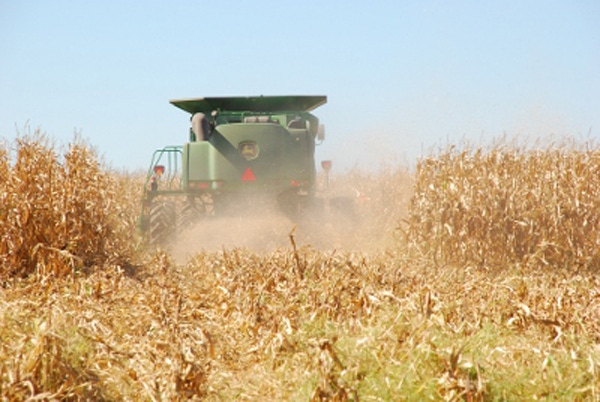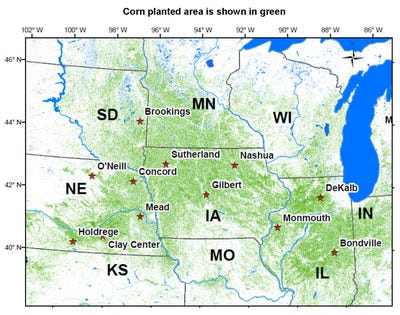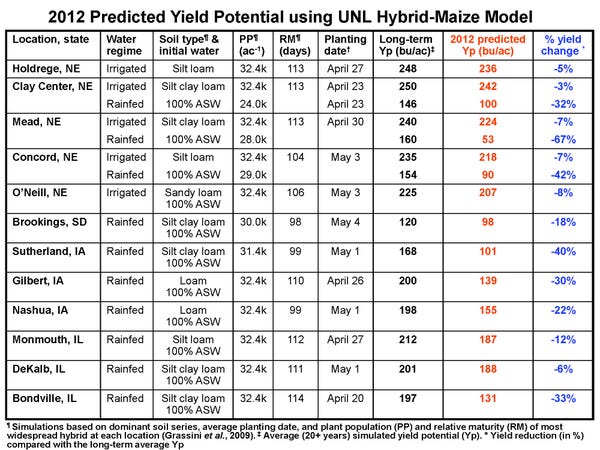September 17, 2012

Hybrid-Maize is a corn simulation model that estimates corn yield potential under irrigated or dryland conditions, based on weather, planting date, hybrid maturity and soil type, assuming optimal crop management. By comparing simulated end-of-season yield potential against the long-term average, it is possible to estimate the expected yield difference.
The question arises: how reliable are these projections? In areas where there has been relatively little heat or water stress, experience indicates that predictions of yield potential using Hybrid-Maize are robust. In contrast, we would expect Hybrid-Maize to underestimate predictions of yield loss in areas where there was high temperature stress during the critical two- to three-day period of pollination, or where there were severe water deficits that reduced development of the leaf canopy before tasseling, These phenomena are not well accounted for in the current version of the model although we plan to release an improved version of Hybrid-Maize later this year that addresses these deficiencies.
Likewise, for irrigated systems that had trouble keeping up with meeting crop water demand, or where there were uneven plant stands or lodging, the model does not “see” these constraints because it assumes no limitations other than temperature and solar radiation for irrigated production, and temperature, solar radiation, and rainfall for dryland production.

Figure 1. Locations used by the Hybrid-Maize model for in-season yield forecasting with actual weather and dominant management practices and soil series at each site (indicated by starts). Green areas indicate where corn is planted. Weather data used is from the High Plains Regional Climate Center and the Water and Atmospheric Resources Monitoring Program through the Illinois Climate Network (Illinois State Water Survey, Prairie Research Institute, and the University of Illinois at Urbana-Champaign).
To evaluate the impact on potential production at 12 sites across the Corn Belt (Figure 1), we used the Hybrid-Maize model to estimate end-of-season yield potential based on actual weather data during the 2012 crop season. Simulations were run for dryland corn in Iowa, Illinois and South Dakota, and for both irrigated and dryland corn in Nebraska. Simulations were based on the typical planting date, hybrid relative maturity, plant population and soil properties at each location. Underpinning data used in these simulations are provided in Table 1.
Findings
The crop reached black layer at all locations during the past two weeks. Therefore, Sept. 10 projections give final estimates of yield potential for dryland and irrigated corn for the 2012 crop season.
Predicted yield potential is below the long-term average at all sites, under both irrigated and dryland conditions.
For dryland corn, there is a modest yield loss (6-18%) for the locations in South Dakota (Brookings) and west-central and north-central Illinois (Monmouth and DeKalb) while a moderate yield loss of 22-30% is predicted for dryland corn in central and northeast Iowa (Gilbert and Nashua).
Severe yield loss of 32-67% is projected for dryland corn in south-central, eastern and northeast Nebraska (Clay Center, Mead, and Concord), northwest Iowa (Sutherland) and south-central Illinois (Bondville).
In contrast to the large loss of yield potential in these dryland systems, projected losses in yield potential at all irrigated sites are modest at 3-5% in south-central Nebraska (Clay Center, Holdrege), and 7-8% in east and northeast Nebraska (Mead, O’Neill, Concord).

The bottom line is that 2012 irrigated yields will be moderately lower than the long-term averages (3-8% below normal), while dryland corn yield potential in much of the Corn Belt will be moderately to severely reduced (22-67% below normal). Keep in mind that yields of both dryland and irrigated corn can be even lower at places where:
High temperature stress occurred at pollination
Irrigated systems were unable to keep up with crop water use demand or there were problems with pivot irrigation nozzles and uneven watering
There were additional stresses from insects and diseases
The initial soil moisture profile at planting was below 100%, as assumed in these corn simulations
Indeed, in many places in Nebraska soil moisture at planting was below full recharge due to a drier than normal winter-spring season. In these areas dryland yields would be reduced below the estimates in Table 1.
Patricio Grassini, Research Associate Professor, Agronomy and Horticulture Department
Jenny Rees, UNL Extension Educator
Haishun Yang, Associate Professor, Agronomy and Horticulture Department
Kenneth Cassman, Professor, Agronomy and Horticulture Department
Link to a larger version of Figure 1 and Table 1.
You May Also Like




